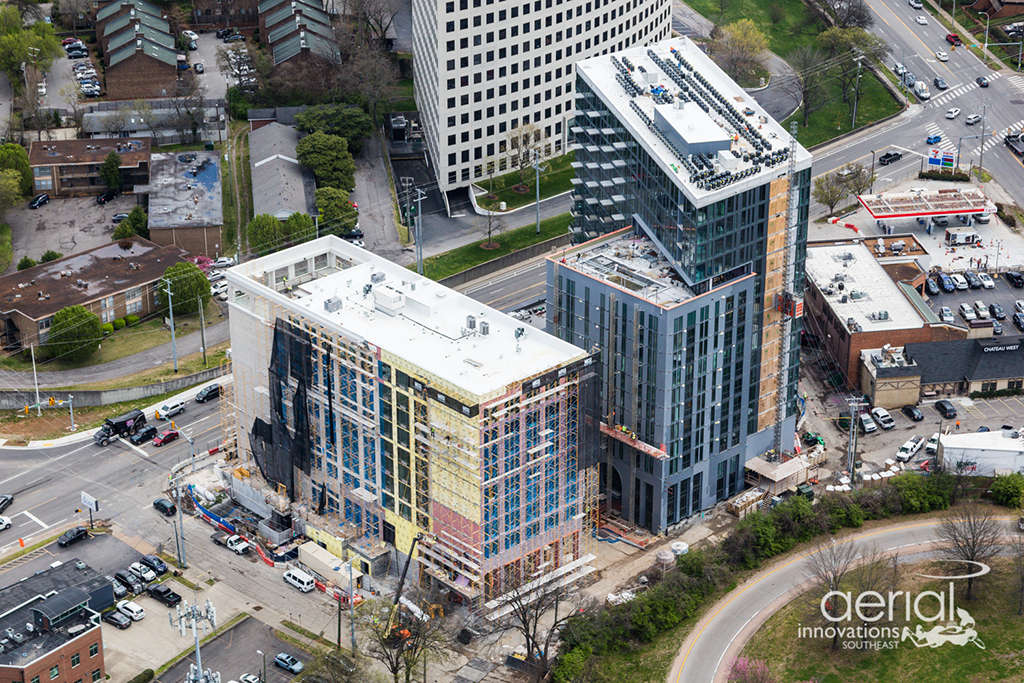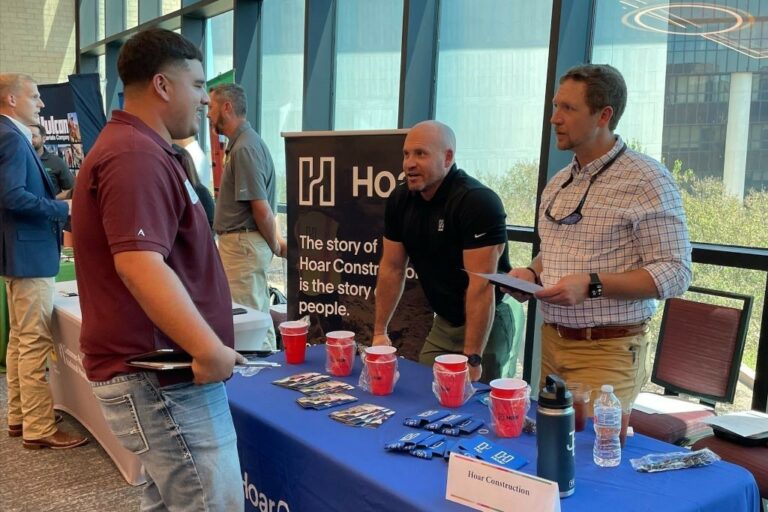
From Brandon Lutz, Senior Construction Manager, GBT Realty & David Howe, Senior Superintendent, Hoar Construction
Our Client’s Perspective
Brandon: On a project like Park West, an urban high-rise luxury apartment tower, relationships are critical. That of course applies to your builder; you have to an excellent relationship with your GC to find success and find the required rhythm in a project that is 17 stories. But beyond the relationships between owner, developer, design team, project team, and trade partners — you have to be able to establish relationships with the people in the community around your project.
The appeal of most urban, downtown properties is that they are located where people want to be. Project sites like the one for Parke West in Nashville are in established, thriving communities. So, when it’s announced a 17-story apartment tower with a two-year schedule is moving into the neighborhood, residents and business owners can be, understandably, skeptical. That’s where the ability to partner with a project team who can establish and maintain positive relationships in the community is a critical element of success. At GBT, we knew that our project would be an asset to the location — transforming the site of a former bank into a beautiful building with street-level retail, new luxury residences, and a hotel. The challenge was communicating with the community our intentions and honoring commitments to keep the impact from construction to a minimum. After all, we want our building and the new residents to be welcomed into the community. That means keeping the people who are already there happy.
On this project, the Hoar Construction team took this challenge head-on. That meant attending every early neighborhood meeting about the proposed project. David Howe and his team regulated parking, kept traffic moving, kept the roads clear, and communicated any major construction updates or road closures to the community in advance. At the end of the day, we’re all neighbors. If you start a bad relationship, you just created a bad relationship for years to come. If you can build a positive relationship by the time your project is finished, it’s great for not only the surrounding community but reverberates and speaks well about all parties for future projects within the city. That’s what happened on Parke West, and it’s why GBT has already placed their trust in Hoar again for two more projects in Nashville.
Beyond Basic Construction Processes
David: In my experience, communities are happy to see completed new buildings, but no one likes to see construction. Neighbors are always concerned about traffic, parking issues, or construction trash making its way outside their homes. That’s why we know that part of our job as general contractors is to not only deliver a building on time and within budget, but also to build the project in a way that establishes and maintains positive relationships with the surrounding community. What good is a beautiful building to our clients if, by the time it’s finished, it has become a sore spot of contention to the neighbors around it?
Here are 4 things a builder needs to manage in addition to their typical construction processes to be a good neighbor in urban developments.
Meet Your Neighbors Early and Often
If there are town hall meetings about the development you’re building, you need to be at every one. Together with GBT, Hoar was at city council and neighborhood meetings where Parke West was on the agenda. We presented detailed parking plans, how we planned to enforce and monitor them, and our plan to keep trash contained to the site. Our jobsite office shared a parking lot with a neighboring restaurant, and we made sure to thoroughly assure them we had a plan to ensure our employees’ parking wouldn’t impact their business.
When you’re building a high-rise tower in a neighborhood, you’re moving in for two years. Not to mention, your client’s tenants are going to be neighbors with the established community for years to come. These early neighborhood meetings are an opportunity you can’t afford to miss to introduce yourself and establish your team as progress-makers, not problem-causers.
Walk the Neighborhood
Once construction begins, you need to walk the neighborhood and visit the surrounding businesses at least once a week. The easiest way to prevent phone call complaints about your project from rolling in is to establish an expectation that your team will be by every week to hear their concerns, issues, and needs. I always ask, “Is there anything we can do for you?” On the Parke West project, we build such solid trust that eventually the neighboring restaurant owner started taking us up on our offer to help. We fixed their oven and repaired a gas leak on some of our visits. Eventually, the owner expressed an interest in repairing the sidewalks outside his business and we were able to work it into our concrete pour easily and with minimal financial impact. The result? The business owner told us, “My place is nicer since you’ve been here.” That’s our goal. To leave communities better than we found them and establish long-lasting, positive relationships by the time our client takes possession of their building.
Stay in Touch
In this age of information being available, expected, and at people’s fingertips, your communication tactics have to go beyond handshakes and hellos. On highly visible projects like Parke West, our team develops website landing pages where we can publish major planned construction activities while detailing any impact on the neighboring tenants and businesses. We make sure to post once a week at minimum to give updates on scheduled concrete pours with specific times and dates. We can give people plenty of notice about lane closures and offer alternative routes and traffic plans so they can plan their commute, minimizing the impact on their schedule and routine. If there’s an activity that will be especially loud like blasting during excavation, we can let the community know far in advance. We’ve found that by taking the unexpected out of the equation and giving people the ability to create alternative plans, community members are far less annoyed by necessary construction activities — even when they impact their daily routine.
Being a Good Teammate First
Most developments have mixed-use components these days, so it’s fairly common to not be the only GC on a project site. We’ve built multiple residential projects in the last two years that also had a hospitality tower on site. Of course, working together with other builders is beneficial to your client’s bottom line as well as the success of your own project scope. But it’s also a key part of being a good neighbor to the community. You must collaborate with the other team daily to coordinate site activities and make sure all construction activities are being communicated with the community. This includes deliveries, concrete pours, and lane closures, not to mention the extensive coordination required when there are two tower cranes on one small site. All the above communication strategies we discussed have to be comprehensive and reliable, otherwise, they won’t have the positive, trust-building impact you’re hoping for.

